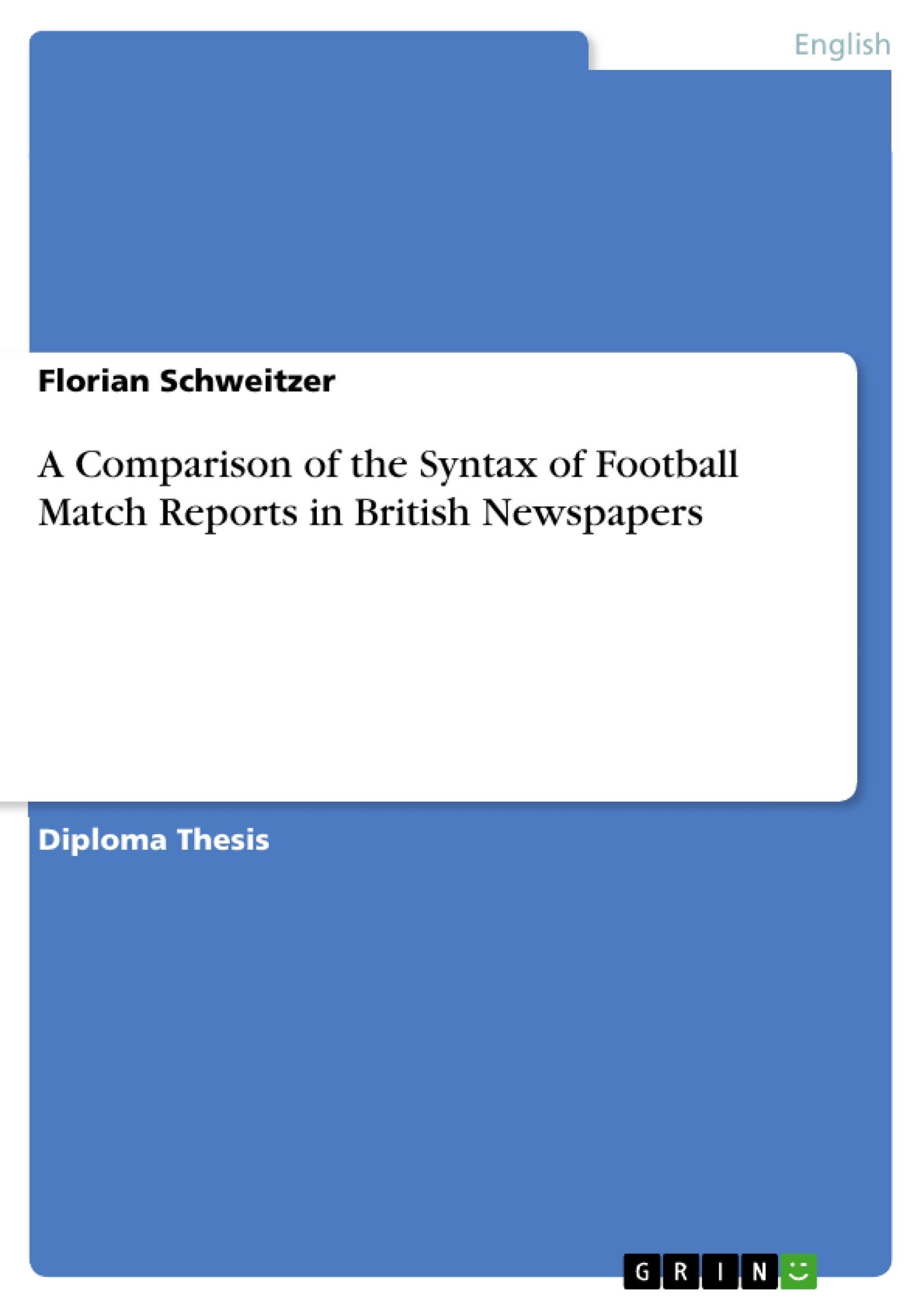“Obviously, everything that happens to be printed in a newspaper or a magazine or written by a journalist is not going to be linguistically homogeneous – nor is there any reason for expecting it to be so” (Crystal/Davy 1969: 173).
This statement by the famous British linguist David Crystal opens a very interesting discussion on the language of print media. If we assume that language as a whole is a vivid and fluid construct that always changes and will never be fixed, it is obvious that nothing which has been printed is linguistically homogenous. However, there are rules and guidelines for the use of language, such as grammar and syntax for example. As language and its use can be investigated, the present study’s aim is to investigate the syntax of newspaper articles that deal with football match reports and to establish similarities and differences between different kinds of newspapers, namely broadsheets and tabloids .
Nowadays, print media can no longer be imagined without sport reporting and particularly the reportage of football matches. Football has become a mainstream pastime and enjoys great popularity. It takes up a considerable part of British newspapers – depending on the targeted readership of the newspaper in question. Even though the sport sections vary in size, they can be found in every single issue and in some newspapers, take up more space than topics with supposedly more impact on peoples’ lives such as politics or economics. Although the newspapers report on the same events, there are notable differences in the manner in which they report on them. If we consider sport reporting, it becomes obvious that the language is always tailored to the audience the newspaper wants to reach. Considering the great variety of newspapers and their differences with regard to focuses and targeted readerships, it can be assumed that there are differences between up-market (broadsheet) and down-market (tabloid) newspapers concerning the style of writing, the research quality or the credibility.
Above all, in the sport section the differences between broadsheet and tabloid reporting become particularly apparent. Even at first glance it is obvious that differences are to be found: not only do the front page designs of the sport sections vary greatly, but it may also be assumed that there are differences concerning the degree of complexity of expression within the articles themselves.[...]
Inhaltsverzeichnis (Table of Contents)
- Introduction
- Field of Research
- Current State of Scientific Research
- Outline of Newspapers Used in the Study
- Tabloids
- Mid-Market Tabloids
- Broadsheets
- Circulation
- Readership Profiles
- The Language of Sports in the Media
- The Language of Newspapers
- The Term "Language of Sports"
- The Football Match Report
- Analysis and Database
- Methodology
- Corpus Linguistics
- Corpus Compilation
- Sentences
- Sentence Length
- Sentence Fragments
- Complexity of Sentences
- Use of Active / Passive Voice
- Type / Token Ratio
- The Use of That
- That-Complement Clauses
- Post Modifiers – That as a Relative Pronoun
- Demonstrative Determiners
- Demonstrative Pronouns
- Distribution of That – Result
- Distribution of That in Relation to Absolute Number of That in Each Newspaper
- Distribution of That in Relation to the Sub-Corpus
- The Distribution of That – A Comparison of Broadsheets and Tabloids
- Methodology
- The syntax of football match reports in British newspapers.
- Similarities and differences between broadsheets and tabloids.
- The impact of readership on language style and complexity.
- The influence of other media, like radio and television, on the written language of sports reporting.
- The role of jargon and specialized language in football match reports.
Zielsetzung und Themenschwerpunkte (Objectives and Key Themes)
This diploma thesis aims to investigate the syntactic differences in football match reports published in British broadsheets and tabloids. By comparing the language used in these different types of newspapers, the study seeks to understand whether the targeted readership influences the complexity and style of writing in football match reports.
Zusammenfassung der Kapitel (Chapter Summaries)
The first chapter introduces the thesis and outlines its main objectives. It also discusses the ongoing debate about the language of print media, highlighting the dynamic and evolving nature of language, and emphasizing the importance of investigating the syntax of newspaper articles.
The second chapter provides a comprehensive overview of the field of research, focusing on previous studies that examined the language of sports reporting. It examines the findings of prominent scholars like Crystal and Davy, Kroppach, Simon-Vandenbergen, Ghadessy, Jucker, Knobbe, and Westin, who have contributed significantly to understanding the language of sports in the media.
The third chapter dives deeper into the specific language of sports in the media, analyzing the characteristics of the language of newspapers, the language of football, and the unique features of the football match report. It discusses the impact of time constraints on writing style and the evolving role of newspapers in the modern media landscape.
The fourth chapter introduces the methodology and database used in the thesis. It discusses the use of corpus linguistics and the compilation of two main corpora, each consisting of 40,000 words, extracted from broadsheet and tabloid newspapers. The chapter then describes the various syntactic criteria investigated, including sentence length, complexity of sentences, type/token ratio, the use of active/passive voice, and the frequency of the word “that”.
Schlüsselwörter (Keywords)
The key focus of this thesis lies in the comparison of the syntax of football match reports in British newspapers, specifically examining broadsheets and tabloids. The investigation delves into key concepts like corpus linguistics, sentence complexity, type/token ratio, passive voice, and the use of "that". The study aims to provide insights into the language of sports reporting, particularly the influence of readership on style and complexity, and the potential impact of other media types on the written language.
- Citation du texte
- Florian Schweitzer (Auteur), 2012, A Comparison of the Syntax of Football Match Reports in British Newspapers, Munich, GRIN Verlag, https://www.grin.com/document/264339



